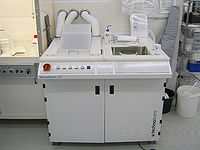Specific Process Knowledge/Thin film deposition/Electroplating-Ni: Difference between revisions
| Line 1: | Line 1: | ||
=<span style="background:#FF2800">THIS PAGE IS UNDER CONSTRUCTION</span>[[image:Under_construction.png|200px]]= | =<span style="background:#FF2800">THIS PAGE IS UNDER CONSTRUCTION</span>[[image:Under_construction.png|200px]]= | ||
'''Feedback to this page''': '''[mailto:labadviser@danchip.dtu.dk?Subject=Feed%20back%20from%20page%20http://labadviser.danchip.dtu.dk/. | '''Feedback to this page''': '''[mailto:labadviser@danchip.dtu.dk?Subject=Feed%20back%20from%20page%20http://labadviser.danchip.dtu.dk/index.php/Specific_Process_Knowledge/Thin_film_deposition/Electroplating-Ni click here]''' | ||
<!-- Replace "http://labadviser.danchip.dtu.dk/..." wih the link to the Labadviser page--> | <!-- Replace "http://labadviser.danchip.dtu.dk/..." wih the link to the Labadviser page--> | ||
Revision as of 14:21, 28 May 2013
THIS PAGE IS UNDER CONSTRUCTION
Feedback to this page: click here
Technotrans microform.200
The Technotrans microform.200 (Electroplating-Ni in LabManager) is a machine capable of depositing nickel electrochemically. This is done by lowering the sample into an electrolyte containing nickel ions and then apply a voltage across the sample and the anode. The anode is a basket filled with nickel pellets. The cathode is the sample to be coated with nickel.
At the anode metallic nickel is oxidized to nickel ions:
Ni (s) ⇒ Ni2+ (aq) + 2 e-
At the cathode (the sample surface), nickel ions from solution are reduced to metallic nickel:
Ni2+ (aq) + 2 e- ⇒ Ni (s)
The minimal charge accepted by the software on the machine is 0.1 Ah (Ampere-hours). This corresponds to roughly 2 µm of nickel on a four inch wafer. You can abort a program prematurely to achieve even lower thicknesses, but this requires manual control of the machine.
The maximum allowed thickness is ~1,4 mm (1400 µm), since higher a thickness will make the release of the sample difficult. This corresponds to a charge of 53-54 Ah on a four inch wafer.
The plating bath is an aqueous solution of nickel sulphamate, boric acid and sulfamic acid. The bath is moderately acidic (pH = 3,5 - 3,8) and the temperature of the bath is 51-52°C. The sample will spin at 60 RPM during deposition.
Uniformity across a 4" wafer is around 5% for the standard processes (the edge being slightly thicker than the center of the sample). Running at high current densities will deposit a nickel layer that is quite soft. Decreasing current density will increase tensile strength of the deposited nickel.
The user manual(s), quality control procedure(s) and results, user APV(s), technical information and contact information can be found in LabManager:

Electroplating-Ni Info on LabManager
Process information
| Parameter | Value | |
|---|---|---|
| Sample dimensions | Diameter |
50, 100 or 150 mm (~ 2", 4" or 6") |
| Sample thickness |
Maximum 1,0 mm | |
| Process parameters | Temperature |
52*C |
| pH |
3,5 - 3,8 | |
| Sample requirements | Seed metal |
100 nm of either NiV, Ti+Au or Cr+Au recommended. Most commonly seed metals are sputtered using the Sputter-System(Lesker). |
| Allowed materials |
Most materials allowed. See below. | |
| Forbidden materials |
Copper, cobalt. See machine manual on LabManager for details | |
